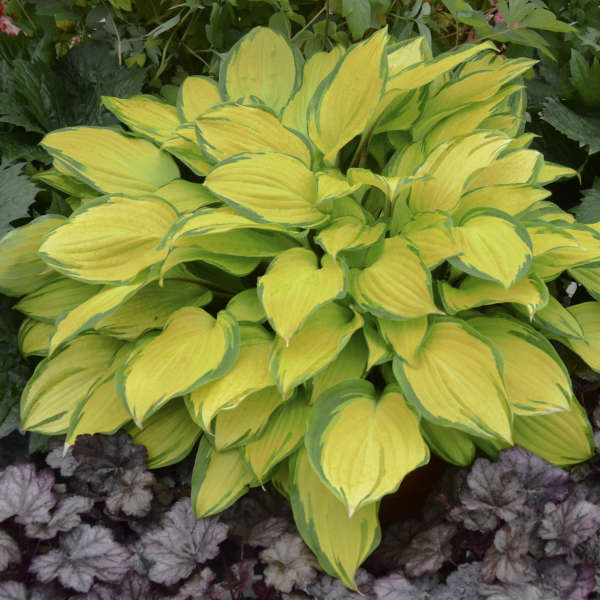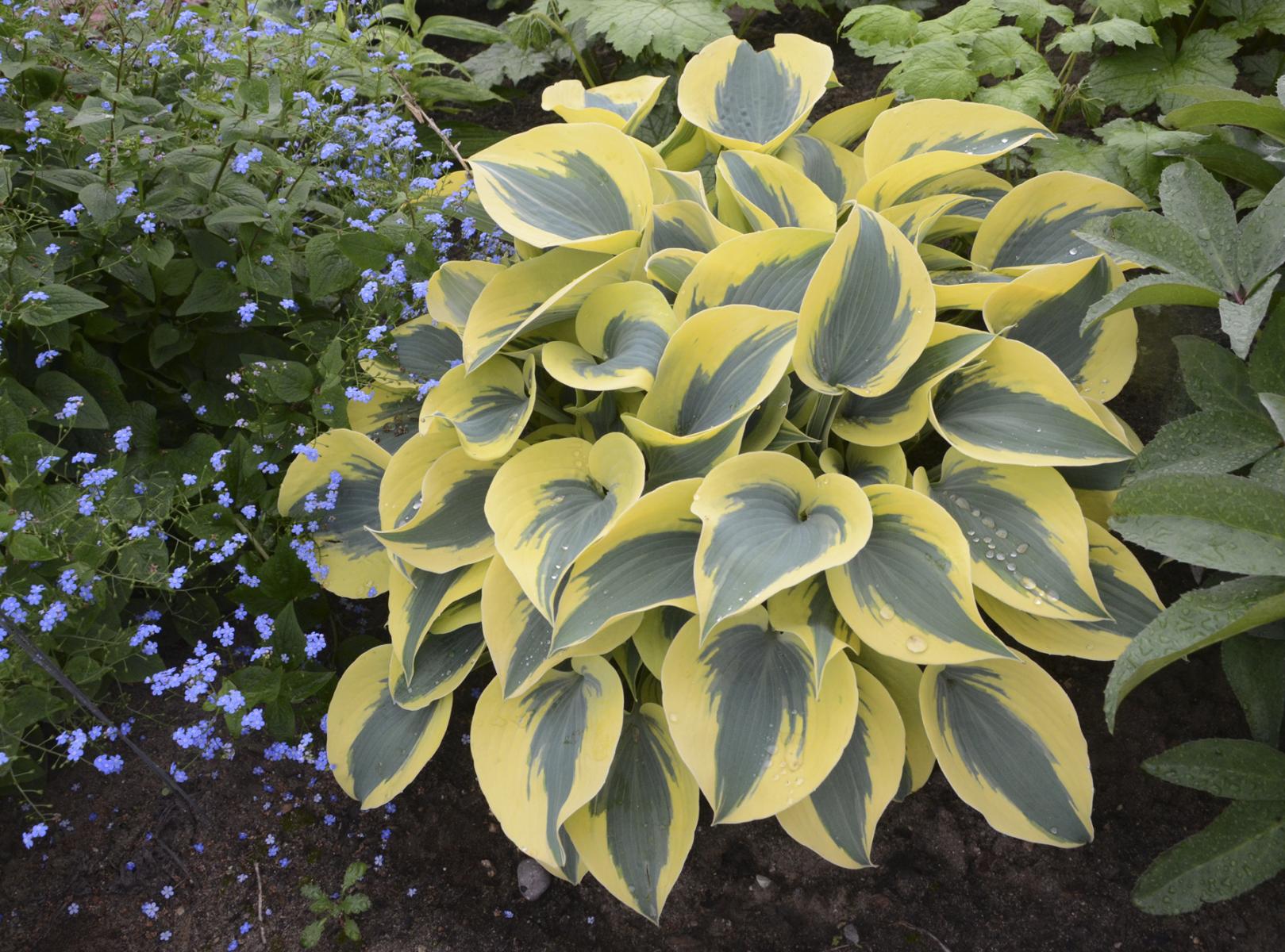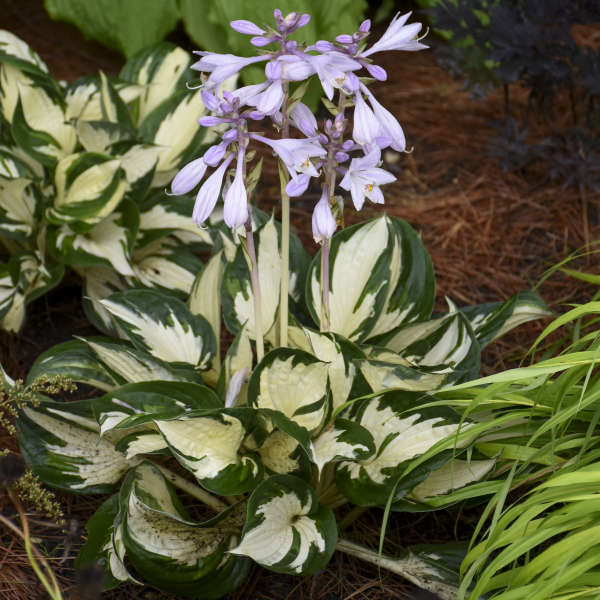
Hosta, or plantain lily, is one of the best, most reliable, plants for home gardens. They thrive in shade – often a challenging area for any gardener - have few pest problems and are reliably hardy in cold climates. There are hundreds of cultivars available offering a wide range of plant sizes, leaf shapes and foliage colors, as well as delicate flowers. No wonder they are so popular!
 So Much Variety!
So Much Variety!
Hostas grow in clumps of oval, heart-shaped or strap-like leaves on individual stems. Foliage colors include various shades of green, chartreuse and blue-gray, often with gold, yellow, cream or white variegation. Some cultivars offer a delightful blend of colors in each leaf, but remember, the more white or cream variegation the less effective the plant will be at photosynthesis. This means plants with larger amounts of white or cream will be less vigorous growers. Leaves may also be smooth or crinkled and wavy, with a dull, glossy or waxy finish.
Flowers are produced on upright stems above the foliage. Flowers range from white through lavender to purple, and some are highly fragrant. Some varieties start blooming in early summer; others in mid- to late summer through frost. If you’re a gardener who doesn’t like hosta flowers, and that’s ok. Simply remove the flower stems as they appear by cutting them down as close to the plant crown as possible. This will have no detrimental effect on plant health.
Hosta’s also vary widely in plant size, ranging from 2 inches to 4 feet. Small types can be planted close together for a low-growing ground cover; large ones can be used in foundation plantings, as specimen plants or in perennial beds to provide a contrast to vertical plants such as delphinium or iris.
 Site Selection
Site Selection
Though hostas will tolerate full shade, the best site for them is actually a partially or lightly shaded location. Some will tolerate full sun if they're mulched heavily and watered regularly, but hostas grown in full sun usually suffer leaf bleaching or dry scorched foliage by mid-summer. Hostas are ideal for flower beds on the north side of a building or fence or in other areas where they'll receive bright indirect light, or light shade but no direct sun.
Choose a site protected from wind and, if possible, from hail. Hosta’s large leaves are easily damaged by wind and hail, which won’t kill plants, but ruins the look of the foliage for a season. Most cultivars will be damaged by winds above 35 mph.
Soil
A deep, organic soil with good drainage is ideal for hostas. If your soil is heavy, compacted or has been disturbed by construction you can improve it for better plant growth by adding 2-3 inches of compost or other organic matter over the planting area and incorporating it to a depth of 10 inches. Avoid planting hostas in areas with poorly drained soil, which can lead to root and crown rots.
Because hostas need a constant supply of moisture, summer mulching is recommended to conserve water and reduce weed competition. However, only apply about 1 inch of a loose organic mulch since thicker mulch layers are likely to promote higher slug populations.
Hostas are easy-care perennials. Pest problems are few and may include slugs in wet years.
Planting
Spring is the best time to plant hostas because it gives plants plenty of time to get well established before either summer's heat or winter's cold. But, if given good care after planting, container-grown plants can be put into the garden about any time the ground isn't frozen.
Hostas can be divided in either early spring or late summer after temperatures have dropped and blooming has ended. Either dig up older plants and cut them into sections with a sharp knife or use a sharp spade to remove offsets while leaving the mother plant in place. Make sure each division has at least two or three buds and plenty of roots.
Keep the plant and its roots moist. Dig a hole slightly shallower than the root ball and at least 1 1/2 times as wide. Place the hosta in the hole with the crown just above soil level and add soil as needed. Do not bury the crown. Do not tamp the fill soil. Water the soil thoroughly to remove air pockets and allow the soil to settle.
Following late summer transplanting, at least one growing season must pass before active aboveground growth will resume. Starter fertilizer (high proportion of phosphorus) may be applied to transplanted hostas to promote root growth. Excess fertilization should be avoided, especially for late summer transplanting, to minimize the potential for delayed hardening off.
Due to the ongoing popularity of hostas and the ever-increasing number of cultivars available, the American Hosta Society is helping gardeners find a new cultivar each year that grows well in all parts of the US, is widely available and retails for about $15.00 in the year of selection. Check out their Hosta of the Year program for recommendations and pictures of past recommendations. Pictured above is the most recent winner, 2022 selection, ‘Island Breeze’.
Images from Walters Gardens.
- There is great variety to choose from, including many different leaf shapes and colors, with so many great cultivars on the market such as this beautiful Hosta 'Autumn Frost'.
- Cultivars like Hosta 'Fire and Ice' with large amounts of white variegation are usually not as vigorous growers as types with more green foliage.